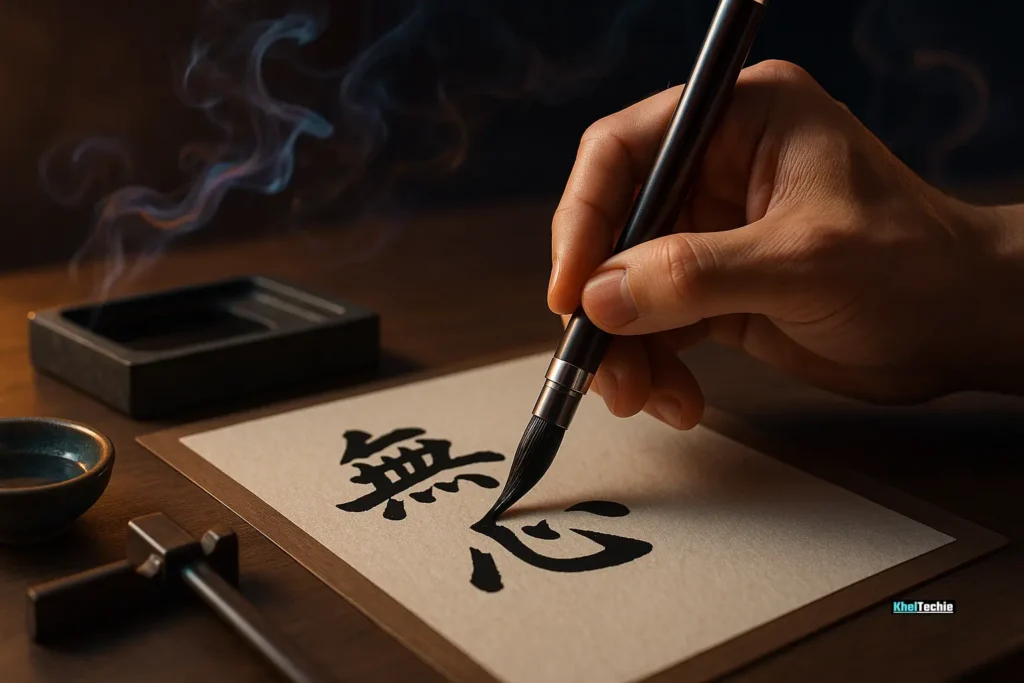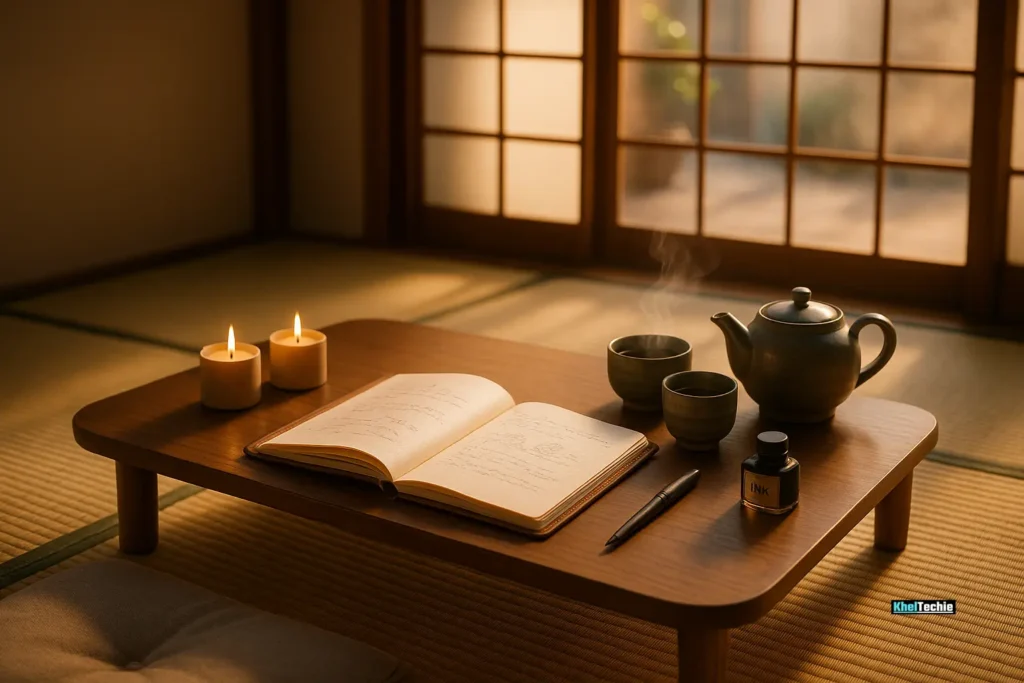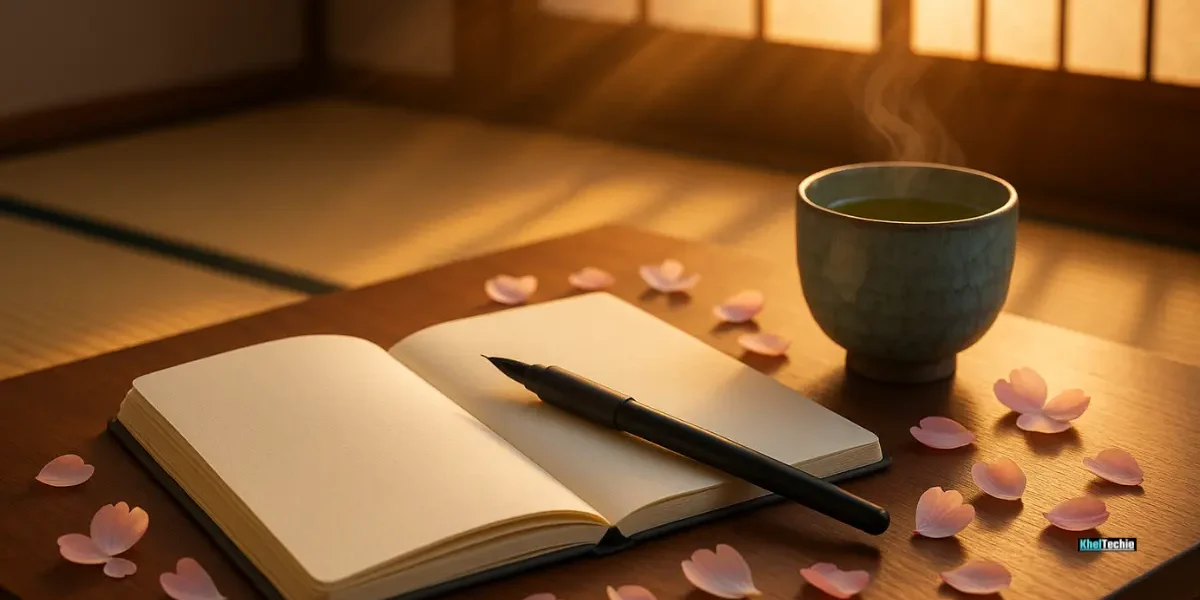Japanese Journaling for Mindfulness: Simple Beginner’s Guide
The Quiet Power of Japanese Journaling
You’ve tried journaling and mindfulness apps, meditation videos but something’s missing, Your mind still races & your thoughts still clutter, You want a simple, culturally rich practice to ground you.
Ever thought about Japanese journaling? It’s a beautiful blend of self-reflection, language and ancient mindfulness traditions. In this guide on How to start Japanese journaling for mindfulness, you’ll discover a roadmap rooted in real experience, psychology-backed methods, and actionable steps that make this practice uniquely transformative.
Also read – Japanese Slow Living at Home

What Is Japanese Journaling for Mindfulness?
Japanese journaling, also known as shūdan no nikki or seikatsu no kisetsu (seasons of life journaling), blends simplicity, intention and nature to help you stay grounded. At its core, Japanese journaling for mindfulness is a reflective writing practice rooted in Japanese culture. It combines elements of Zen philosophy, Shinto rituals and traditional aesthetics to help you cultivate presence, gratitude and self-awareness.
Think of it as your zen diary, a space where you slow down, notice and reflect through Japanese language or concepts. Unlike themed journaling, it blends:
- Language practice – even basic kana/kanji deepen focus.
- Cultural wisdom – drawing on ikigai (purpose), kaizen (tiny improvements), or yutori (spacious awareness).
- Mindfulness habit – a calm ritual with analog tools like fountain pens or brush pens.
It’s like a morning tea ceremony, but instead of tea, you have words; instead of grace, you hold your attention gently on paper. Japanese journaling isn’t just about recording the day, it’s about reflecting on the quality of your thoughts, emotions and experiences.

Why Japanese Journaling for Mindfulness Matters
In today’s chaotic world, finding inner stillness can feel impossible. That’s where Japanese journaling for mindfulness steps in, not just as a hobby, but as a healing ritual. More than simply writing your thoughts, this practice blends cultural wisdom with emotional awareness to calm the mind, gently.
According to a 2025 study published in Frontiers in Psychology, Japanese professionals who practiced mindfulness through structured journaling sessions experienced measurable increases in self-compassion, emotional clarity, and even better communication. For busy employees, integrating quick journaling practices had almost immediate positive effects, promoting not only productivity but also genuine self-compassion. This shows that the power of mindfulness lies in its adaptability, Japanese journaling practices meet you exactly where you are, fitting into a hectic lifestyle without demanding drastic changes
Beyond performance, Japanese journaling carries a much deeper purpose. According to therapist Kim Egel, journaling helps people process emotions, reduce anxiety and gain mental clarity especially when it’s done intentionally. In her December 2024 blog post, she emphasizes how mindful journaling reconnects you to your thoughts, values, and personal growth. If you pair this with Japanese concepts like ikigai (life purpose) or kaizen (tiny improvement), the benefits multiply.
So, whether you’re jotting down a gratitude list in English or writing a calming kanji like “無心” (mushin – no-mind), this daily habit becomes your pause button in a busy life. It’s quiet, personal and deeply human.
In short, Japanese mindfulness journaling doesn’t just help you feel better, it helps you become more you.

How to Start Japanese Journaling for Mindfulness
Let’s get practical, here’s a step-by-step guide to help you start your own Japanese-style mindfulness journal, no Japanese language skills required.
Step 1: Choose Your Tools
You don’t need fancy supplies, but the right tools can make the experience more enjoyable.
Essentials:
- Journal: Go for a simple notebook or a Japanese-style journal like Moleskine Cahier, Hobonichi Techo or MIDORI MD Paper.
- Pen: Use a gel or brush pen for smooth writing and aesthetic appeal.
- Optional: Stickers, washi tape or watercolors for decoration.
Step 2: Pick a Japanese Journaling Style
There are several styles to choose from. Pick one that resonates with you.
| Style | Focus | Best For |
|---|---|---|
| Seikatsu Nikki (Life Diary) | Daily reflections | Beginners |
| Gratitude Journaling | 3 things you’re grateful for | Positivity |
| Kintsugi Journaling | Healing emotional wounds | Emotional growth |
| Shinrin Yoku Journaling | Nature observations | Stress relief |
| Hibi Nikki (Daily Diary) | Simple daily entries | Consistency |
Step 3: Set a Time and Space
Japanese journaling works best when done consistently.
- Best Time: Morning (to set a positive tone) or evening (to reflect on the day).
- Best Space: A quiet corner, a park or anywhere you feel at peace.
Pair it with a small ritual like lighting a candle or making tea, to make it feel sacred.
Step 4: Use Prompts or Templates
Start with structured prompts to build the habit.
📝 Sample Prompts:
- What 3 things am I grateful for today?
- What moment brought me peace today?
- What challenge did I face and how did I grow from it?
- What did I learn about myself today?
- How did I treat myself with kindness today?
You can also use templates like:
- Morning Gratitude + Intention
- Evening Reflection + Gratitude
- Weekly Review + Goals
Step 5: Keep It Simple and Authentic
Don’t overthink it.
- Write in your native language.
- Use short sentences.
- Be honest, no one else needs to read this.
- Embrace imperfection. This isn’t for Instagram, it’s for your soul.
Step 6: Add Aesthetic Touches
Make it visually pleasing to enhance mindfulness.
- Use brush pens or colored ink.
- Add seasonal themes (like cherry blossoms in spring).
- Decorate with small drawings or stickers.
Step 7: Reflect Weekly
Once a week, review your entries.
Ask yourself:
- What patterns do I notice?
- What brings me joy?
- What drains my energy?
- What changes do I want to make?
This helps deepen self-awareness and supports long-term growth.

Common Mistakes to Avoid & It’s Fixes
Even with the best intentions, it’s easy to fall into traps. Here are some common mistakes and how to avoid them.
| MISTAKE | WHY IT’S A PROBLEM | HOW TO FIX IT |
|---|---|---|
| Overcomplicating the process | Adds stress, not peace | Keep it simple: 3–5 sentences a day |
| Forcing daily entries | Can lead to burnout | Aim for 3–5 days a week |
| Comparing your journal to others | Undermines authenticity | Make it personal and unique |
| Ignoring the seasonal rhythm | Misses the cultural context | Use nature as a guide |
| Not creating a ritual | Reduces mindfulness effect | Light a candle, sip tea or play soft music |
Also read – How to Start a Gratitude Journal in 2025 for Mental Wellness & Joy

Final Thoughts: Start Small, Go Deep
Starting Japanese journaling for mindfulness doesn’t require perfection, just presence. It’s not about filling pages or writing beautifully, it’s about showing up for yourself, day after day and creating space for stillness in a noisy world. Whether you’re dealing with stress, seeking clarity or simply curious about mindfulness, this practice can become your anchor. So grab a notebook, find a quiet spot and begin, Your journey to inner peace starts now.
Have questions or want to share your experience? Leave a comment below or tag us on social media with your journaling journey and if you found this guide helpful, please share it with someone who could use a little more mindfulness in their life.
This article is for informational and educational purposes only. It does not constitute medical, psychological, or professional advice. Always consult a qualified health or mental wellness expert before beginning any new mindfulness or journaling practice.
FAQs: Your Japanese Journaling Questions Answered
Do I need to know Japanese to do Japanese journaling?
Nope! Japanese journaling is more about the mindset than the language. You can write in English, Spanish, or any language you’re comfortable with.
How long should I journal each day?
Start with 5–10 minutes. As you get more comfortable, you can extend it to 15–20 minutes.
Can I do Japanese journaling digitally?
Absolutely! Use apps like Notion, GoodNotes, or Bear Notes. Just keep the same reflective and mindful approach.
What if I don’t know what to write?
Use prompts or templates. Over time, ideas will flow more naturally.
Is Japanese journaling the same as bullet journaling?
No. Bullet journaling is more task-focused, while Japanese journaling is reflective and mindful.
What are the best journals for Japanese journaling?
Try:
- MIDORI Traveler’s Notebook
- Hobonichi Techo (with sticker kit)
- Moleskine Cahier
- Field Notes
Can I share my journal with others?
You can, but many people keep it private for deeper honesty and reflection.
Does Japanese journaling really reduce stress?
Yes. Studies show that reflective writing lowers cortisol levels and improves emotional regulation.
What’s the best time to journal?
Morning or evening — whichever works best for your schedule and mindset.
How do I stay consistent with journaling?
Set a daily reminder, pair it with a habit (like morning coffee), and keep your journal visible.




